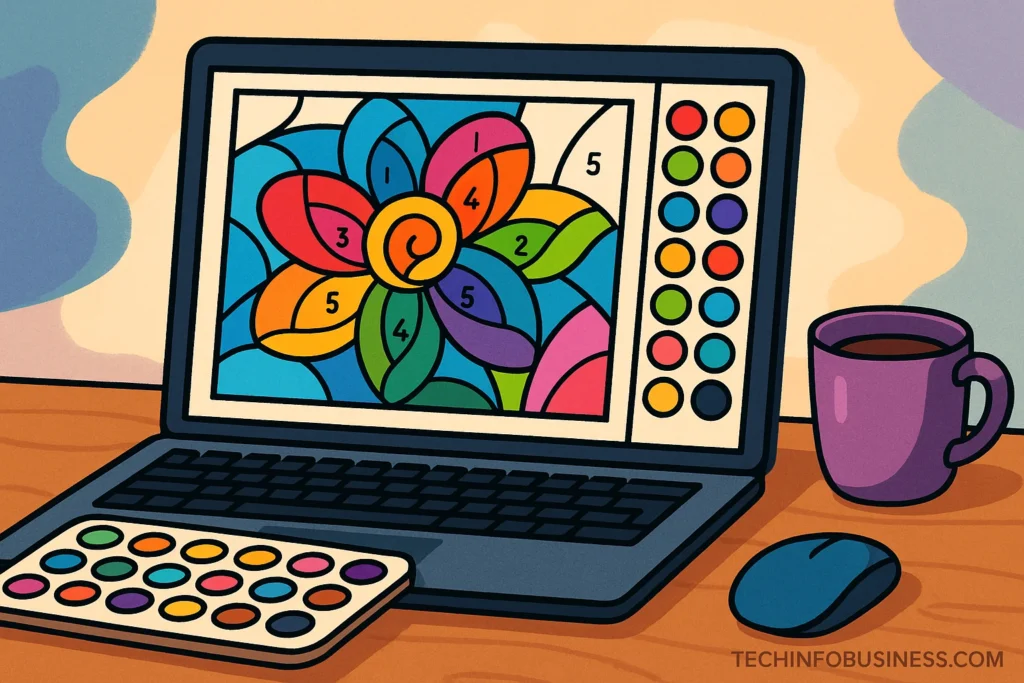When I first discovered Happy Color Coloring Book on my smartphone, I loved how relaxing it was to fill tiny details with vibrant shades. But after weeks of playing, I realized two things: my phone screen was too small, and my fingers often made mistakes in narrow spaces. That’s when I began searching for ways to use Happy Color on PC. With the help of Usitility and Android emulators, I managed to set it up, and it completely changed my coloring experience. Not only did I get a bigger canvas, but I also gained smoother performance, better ergonomics, and the ability to save artwork in high resolution.
In this guide, I’ll share everything I’ve learned about installing and optimizing Happy Color on your computer, plus real-world tips that come from my own trial and error. Whether you’re a casual player or someone who spends hours coloring like me, these steps will help you turn Happy Color into a relaxing creative ritual on your desktop or laptop.
Choosing the Right Setup for Happy Color PC
Before you download Happy Color on your computer, you need to make sure your setup can handle an emulator. Emulators simulate a smartphone environment, which naturally consumes more memory and processing power than a lightweight app. From my own experience, a computer with at least 4GB of RAM and a dual-core processor is the minimum requirement, but to enjoy the smoothest coloring sessions, 8GB RAM and a mid-range CPU (like Intel i5 or AMD Ryzen 5) are much better.
I also discovered that the display size matters a lot. On a 14-inch laptop, coloring felt comfortable but still a little constrained, whereas on my 24-inch external monitor, every detail popped. Colors looked sharper, zooming into tiny sections became easier, and my eyes felt less strained. So if you have a larger monitor, I recommend connecting it—you’ll be surprised how much difference it makes in appreciating the artwork.
Another consideration is whether you’re using Windows or Mac. Both support emulators like BlueStacks, but I noticed performance can vary depending on your system resources. Windows tends to run emulators slightly smoother, but with the right setup, Mac users can enjoy the same relaxing coloring sessions too.
How to Install Happy Color on PC with Usitility
One of the most user-friendly ways to set up Happy Color on a computer is by using Usitility. Instead of searching for random emulators, Usitility provides a guided installation that pairs Happy Color with BlueStacks or another reliable emulator. This makes it easier for beginners, since all the technical steps are already streamlined.
The process is simple: first, visit the official Usitility website and search for Happy Color Coloring Book PC download. Once you download their installer, it will automatically set up BlueStacks (or a compatible emulator) on your machine. After installation, you just need to log into your Google Play account inside the emulator and install Happy Color like you would on your phone.
I learned the hard way that downloading from unofficial sources can be risky. A few years ago, I tried an alternative emulator installer from a random blog, and it came bundled with unwanted software. Since then, I only use trusted sources like Usitility. This not only protects your PC from malware but also ensures smoother updates and compatibility.
Configuring Emulator for Best Performance
After installation, many users stop at the default settings. But I quickly realized that without optimization, Happy Color can feel slow and frustrating. The first time I tried, the app lagged every time I zoomed in on a detailed image, which ruined the relaxing vibe. That’s when I started exploring the emulator’s performance settings.
The best configuration I found is to allocate 2–4GB RAM and 2 CPU cores exclusively for the emulator. If you have a graphics card, enabling hardware acceleration (DirectX or OpenGL, depending on your system) also improves rendering significantly. This way, the pictures load faster, colors fill instantly, and there’s no noticeable delay when moving around the canvas.
Another trick is to map mouse controls so that clicks simulate touch. With this setup, the mouse pointer feels just like your finger, but with far more precision. I sometimes even use a stylus with a drawing tablet connected to my PC, which makes the experience very close to real-life coloring with pencils or markers.
Creating a Comfortable Coloring Experience
Technical setup is one part of the equation, but comfort is just as important. When I first started coloring on my laptop, I used the built-in trackpad, and my hand cramped up within 20 minutes. Switching to a wireless mouse made a world of difference, as it allowed me to relax my wrist and color for longer sessions.
Another tip I discovered is to use hotkeys for frequently used actions. For example, I set keyboard shortcuts for zoom in, zoom out, and undo. This not only saves time but also prevents constant hand movements back and forth between the palette and the picture. It makes the workflow smoother, especially when coloring images with hundreds of tiny sections.
Lastly, posture matters. I usually place my laptop on a stand at eye level and use an external keyboard and mouse. It may sound unnecessary, but after hours of coloring, it prevents neck strain and makes the entire experience more enjoyable. The goal is to focus on the calming process of coloring, not on physical discomfort.
Faster Color Selection on PC
One of the biggest benefits of Happy Color on computer is speed. On mobile, my fingers often missed tiny areas, and I had to constantly zoom in and out. On PC, I use the mouse wheel to zoom quickly, then click with precision. This speeds up the coloring process and makes it feel smoother.
I also keep the color palette docked near the coloring area to minimize cursor travel. This little adjustment may seem minor, but over the course of a long session, it saves dozens of unnecessary movements. It’s especially useful when working on images with many shades of the same color, like landscapes or mandalas.
Over time, these adjustments turned Happy Color from a casual app into a mindful activity. I could relax, sip coffee, and focus on filling colors without being interrupted by clunky navigation. It became less about finishing the picture quickly and more about enjoying each stroke of digital color.
Saving and Exporting Artwork from Happy Color
On mobile devices, saving artwork can sometimes be limited or result in lower-resolution images. On PC, however, I discovered several ways to export and preserve my creations in high definition. The simplest method is to use the emulator’s screenshot tool, which captures the artwork in full screen. For even better quality, I sometimes use Windows’ built-in Snipping Tool or third-party screen capture software.
I’ve built a personal gallery of my completed works on my computer, sorted into folders like “Landscapes,” “Animals,” and “Patterns.” Having these saved in HD also allows me to print some of my favorite pieces. There’s something satisfying about holding a physical print of digital art that you spent hours coloring.
One important lesson I learned is to save progress frequently. Emulators, while powerful, can sometimes freeze or crash. I lost nearly two hours of work once when the app stopped responding. Since then, I’ve made it a habit to export progress every 15–20 minutes. It’s a small step that saves a lot of frustration.
Troubleshooting Common Issues
Running apps through an emulator isn’t always flawless. In the beginning, I faced issues like sudden app crashes, lag, and distorted colors. Over time, I built a checklist of solutions that helped me fix almost every problem.
For lagging or freezing, the fix is usually to allocate more RAM and CPU in the emulator settings. Sometimes, simply closing other background programs also frees up resources. For graphic glitches, updating your graphics card drivers is essential. Switching between DirectX and OpenGL modes inside the emulator settings can also make a huge difference.
If Happy Color crashes repeatedly, clearing the app cache or reinstalling it usually works. In rare cases, I’ve had to completely reinstall the emulator, but that’s only when everything else failed. My advice is to not panic when issues arise. Most of the time, a quick settings adjustment solves the problem.
Advanced Tweaks for Power Users
Once you’re comfortable with the basics, you can take your Happy Color PC experience further with advanced tweaks. One of my favorite tricks is creating macros—shortcuts that automate repetitive actions. For example, if I know I’ll be switching between certain colors frequently, I create a macro that speeds up the process.
Another useful feature is cloud syncing. By linking Happy Color to my Google account, I can switch between devices without losing progress. Sometimes I start a picture on my PC at home, then continue coloring on my phone while commuting. The sync keeps everything seamless.
Finally, adjusting display scaling allows you to sharpen details on high-resolution monitors. This is especially helpful when coloring images with intricate designs. It not only makes the experience more enjoyable but also ensures the finished artwork looks crisp and polished.
Why Happy Color on PC Feels Different
Coloring on a phone is convenient, but using Happy Color on PC feels like stepping into a whole new world. The larger screen transforms the app from a casual time-killer into a full creative experience. I find myself getting lost in the details, almost like I would with real coloring books and pencils.
It’s also become part of my personal relaxation routine. After a stressful day, I grab a coffee, put on some calming music, and open Happy Color on my PC. The combination of colors, precision, and comfort turns it into a mindfulness activity. Unlike fast-paced games, there’s no pressure—just the joy of creating something beautiful.
I never expected a mobile coloring app to become such a meaningful part of my routine, but moving it to PC made all the difference. It’s not just about filling spaces with colors—it’s about slowing down, focusing, and enjoying the moment.
Read More: The Ultimate Guide to Commercial Painting in Brampton: Everything You Need to Know
Final Thoughts
Switching Happy Color from mobile to PC has been a game-changer for me. Thanks to Usitility and emulators like BlueStacks, the installation process is simple, and with a bit of configuration, the experience becomes smoother than ever. From saving artwork in HD to setting up ergonomic controls, every small tweak adds up to a better, more relaxing coloring journey.
If you’ve been using Happy Color only on your phone, I highly recommend trying it on your computer. With the right setup, it transforms into a hobby that combines creativity, relaxation, and even productivity. The ability to save, share, and print your creations adds a whole new layer of satisfaction.
Happy coloring! 🎨



